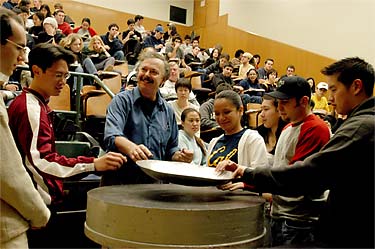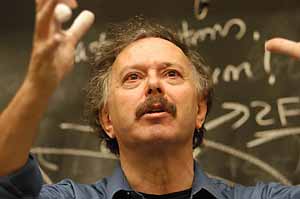Bubba and Dubya meet Sir Isaac
Physicist Richard Muller helps prepare tomorrow’s leaders for a technological world
![]()
| 26 February 2003
| |  Though he designed Physics 10 to help future leaders understand scientific issues, Richard Muller insists the subject should be of interest to “everybody in the United States.” Peg Skorpinski photos |
Not every Berkeley student who takes a course in physics plans to become a physicist. The students who sign up for Richard Muller’s Physics 10 course, “Physics for Future Presidents,” include liberal arts and economics majors — future leaders in law, politics, diplomacy, business, and education. Designed for nonmajors, Physics 10 is a popular one-semester course that teaches the important and interesting aspects of physics using real-world examples.
“I think of physics as the liberal arts of technology,” says Muller. “You understand the fundamental aspects of physics, and then you can learn the technology and understand how it relates to current world problems. I’m teaching the elementary physics that is most useful for someone who’s trying to live in a technological world, to contribute to that world, and to make correct decisions.
“Most of what I teach in Physics 10 has to relate either to current events — things that have just been in the newspapers — or to issues that are clearly important to the students. A future leader needs to have a view of the possibilities for space travel, for superconductivity; of what are the dangers of terrorist attacks, or the potential for solar power.”
Dynamite and dinosaurs
 Rich Muller in action |
In his lectures, Muller often takes novel approaches to grab students’ attention and pique their curiosity. His first class session, on energy and power, starts off with a bang — an asteroid the size of Mt. Everest colliding with Earth, creating an explosion more than 10,000 times greater than the combined U.S. and Soviet nuclear arsenals. From that vivid introduction, Muller explains why the asteroid caused an explosion. He then proceeds to discuss the energy density of different materials — from gasoline and chocolate-chip cookies to bullets, batteries, and TNT.
“I explain that a pound of gasoline has 15 times the energy of a pound of dynamite,” he says. “That surprises everybody, but it’s true. We use dynamite not because it has a lot of energy but because it can release it very quickly.” Eighteen months ago, the first lecture’s lesson proved all too pertinent, Muller says. “A week later airplanes crashed into the World Trade Center, releasing an enormous amount of energy. None of my students were surprised that the terrorists didn’t bother to carry dynamite, because they already knew the amount of energy stored in gasoline far exceeds that in an equivalent amount of dynamite.”
An example to start
“I never begin with a concept,” says Muller. “I always begin with a specific example. I’ll start my lecture by talking about something that’s obviously important that they clearly want to know about. I’ll then say a few things that surprise them, that they didn’t expect to be true. At this point.... I have their curiosity up. I go on to describe the underlying physics that makes the surprising thing not surprising anymore. Next time something comes up in the world that’s related to this, they’ll remember it because it was important to them when they learned it.”
Muller is the author of several books. “Nemesis,” which reads like a scientific detective novel, describes the search for a hidden star orbiting the sun whose gravity draws asteroids and comets into a collision course with Earth. “The Three Big Bangs” describes a series of violent events that shaped the universe, our solar system, and life on Earth. “Ice Ages and Astronomical Causes” is meant for students or researchers who want to learn how to do spectral analysis of paleoclimate data. And in his first novel, “The Sins of Jesus,” Muller blends historical facts with biblical accounts to present an alternative portrayal of Jesus as a man, prophet, and teacher.
Muller’s writing and research also enriches his Physics 10 curriculum. For example, chapters from “Ice Ages and Astronomical Causes” provide perspective on the physics and politics of global warming — reflecting his belief that physics can be learned in terms of things that are interesting, relevant, and important. At the same time, his monthly column for the MIT publication "Technology Review" is based in part on his classroom lectures. Recent columns have addressed terrorism-related topics, Iraqi weapons inspections, airport security, and the North Korean threat.
“I’m assuming that everyone in this class is going to be a leader some day,” says Muller. “My goal is to show them they can really understand the technological world, that they can look beyond the newspapers and understand things in order to make wise decisions. The president of a major corporation has to understand technology to have a vision of where the company and the world are going. Understanding technology is even more urgent for the politician, who has to make rapid decisions that may have enormous consequences.”
Such knowledge isn’t valuable only to future leaders. “There’s nothing in my course that shouldn’t be known by everybody in the United States,” says Muller. “With a technological background one can have a reasoned understanding of the issues, which is important for everybody.”
As one of Muller’s students explained to listeners of the CBS radio program “The Osgood File” when it produced a segment on Muller’s course: “It’s not just for future presidents. Anybody who votes should know these things. If you know these things you’re going to be able to communicate with more people, make better decisions, and do more for yourself and for others.”

